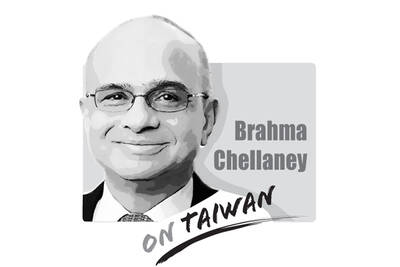On Jan. 2, the New York Times published an article titled “How Taiwan Plans to Stay (Mostly) Covid-Free,” which asks the question: How much longer can Taiwan’s good fortune last?
The article describes Taiwan as a “twilight zone” of an “alternate reality” where life goes on as normal amid a pandemic that has wreaked havoc on so many countries around the world.
By March last year, the COVID-19 pandemic had reached New York City and I, as a doctoral student at New York University, continued living in the city for another five months before returning to Taiwan.
A range of epidemic control measures — including mask wearing, social distancing, meticulous handwashing and even sealing off the city — were employed by the local authorities. The measures certainly had an effect in reducing the impact of the initial wave of the pandemic.
Comparing the respective successes that Taiwan and New York City have had in combating COVID-19, sealing ourselves off from China should be the primary means of pandemic prevention and control ahead of these other measures.
As a matter of course, mainstream media outlets around the world should adopt a skeptical attitude toward any information and news emanating from China.
Right from the start, when news of a mysterious novel coronavirus outbreak in China’s Wuhan first came to light, the Chinese government began to spread misinformation.
Chinese officials initially claimed that there was no human-to-human transmission. When that became untenable, they said there was only “limited” human-to-human transmission. When that was proved to be demonstrably false, officials began to push the line that the epidemic was “preventable and under control.”
China’s “preventable and under control” pandemic has now infected more than 92 million people, caused almost 2 million deaths and incalculable global economic losses.
The New York Times is one of the oldest publications within the US’ fourth estate. However, aside from updating its readers on the virus’ spread and mutation, and providing criticism of the handling of the virus by US President Donald Trump’s administration, it has run precious little coverage of Beijing’s COVID-19 cover-up. This leads one to question whether, behind the scenes, there are other considerations at play.
Following the outbreak of the pandemic, Taiwanese crowd-sourced a “Taiwan Can Help” advertisement in the New York Times. The underlying message was that Taiwan can help, not just in terms of providing medical equipment and resources, and other assistance to nations affected by COVID-19, but also by helping countries around the world to put up the defenses they need to protect themselves from China.
The US and European nations are now in the process of vaccinating their populations against COVID-19. As we wait for the world to return to normal, we must ensure that China is fully held to account for all the damage, death and destruction caused by the pandemic.
Chien Mu-hua is a doctoral student at New York University’s Courant Institute of Mathematical Sciences.
Translated by Edward Jones

Donald Trump’s return to the White House has offered Taiwan a paradoxical mix of reassurance and risk. Trump’s visceral hostility toward China could reinforce deterrence in the Taiwan Strait. Yet his disdain for alliances and penchant for transactional bargaining threaten to erode what Taiwan needs most: a reliable US commitment. Taiwan’s security depends less on US power than on US reliability, but Trump is undermining the latter. Deterrence without credibility is a hollow shield. Trump’s China policy in his second term has oscillated wildly between confrontation and conciliation. One day, he threatens Beijing with “massive” tariffs and calls China America’s “greatest geopolitical
Ahead of US President Donald Trump and Chinese President Xi Jinping’s (習近平) meeting today on the sidelines of the APEC summit in South Korea, an op-ed published in Time magazine last week maliciously called President William Lai (賴清德) a “reckless leader,” stirring skepticism in Taiwan about the US and fueling unease over the Trump-Xi talks. In line with his frequent criticism of the democratically elected ruling Democratic Progressive Party — which has stood up to China’s hostile military maneuvers and rejected Beijing’s “one country, two systems” framework — Lyle Goldstein, Asia engagement director at the US think tank Defense Priorities, called
A large majority of Taiwanese favor strengthening national defense and oppose unification with China, according to the results of a survey by the Mainland Affairs Council (MAC). In the poll, 81.8 percent of respondents disagreed with Beijing’s claim that “there is only one China and Taiwan is part of China,” MAC Deputy Minister Liang Wen-chieh (梁文傑) told a news conference on Thursday last week, adding that about 75 percent supported the creation of a “T-Dome” air defense system. President William Lai (賴清德) referred to such a system in his Double Ten National Day address, saying it would integrate air defenses into a
The central bank has launched a redesign of the New Taiwan dollar banknotes, prompting questions from Chinese Nationalist Party (KMT) legislators — “Are we not promoting digital payments? Why spend NT$5 billion on a redesign?” Many assume that cash will disappear in the digital age, but they forget that it represents the ultimate trust in the system. Banknotes do not become obsolete, they do not crash, they cannot be frozen and they leave no record of transactions. They remain the cleanest means of exchange in a free society. In a fully digitized world, every purchase, donation and action leaves behind data.